Arcerion Tank Regiment
| Arcerion Tank Regiment | |
|---|---|
| ATR | |
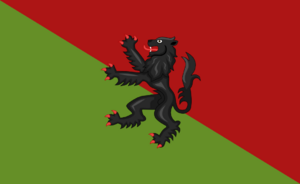 | |
| Active | 1929-present |
| Country | Arcerion |
| Type | |
| Role | Armour |
| Size | ~2,500 (2020s) |
| Garrison/HQ | Corbray Barracks, Arcerion Armed Forces Base Presdale |
| Motto(s) | "Forgo the odds" |
| Anniversaries | 31 January 1929 (founding) 12 October 1991 Battle of Westchester |
| Engagements | Arcer Bush Wars, Ardmori Civil War, Second Great War, Telekonese Conflict, Final War of the Deluge |
| Commanders | |
| Commanding Officer | LCol Rowan O'Sullivan |
| Regimental Sergeant Major | WO1 Keelan Rogers |
The Arcerion Tank Regiment is the senior armoured regiment of the Arcer Army's Armoured Corps. It consists of different squadrons and sub-units, both regular and reserve, each of which forms their own individual regiments within their individual brigades. The Regiment has the distinction as the oldest organized modern armoured regiment in mainland Crona, and shares its multitude of battle honours with other infantry and cavalry regiments from Arcerion. It forms the main armoured core of 1 Rifle Brigade, as well as 4 Mechanized and 5 Mechanized Brigades. The Regiment's main purpose is the conduct of maneuver warfare via its main battle tanks and armoured fighting vehicles, and is the only dedicated armoured regiment in the Army that is primarily focused on main battle tanks.
The Regimental motto of 'Forgo the Odds" is drawn from its participation at the Battle of Westchester, where the entirety of the Regiment fought for the first time, despite being outnumbered by Kelekonese forces, and then Commanding Officer Lieutenant-Colonel Anthony MacGuire commented the phrase when asked if he was concerned about the numerically superior forces.
The Regiment is currently undergoing a significant change and re-evaluation as part of the 2022 Confederate Memo on Defence.
History
After the use of early armoured landships by Levantine armies during the First Great War, Arcer defense attache Colonel Patrick MacGowan sent correspondence from his post as the Arcer Defense Attache to Urcea on the need for these new types of fighting vehicles. This coincided with the increased use of motorisation by modern Levantine Armies. The letter noted that armoured vehicles should be accompanied by truck-bone infantry, or in some cases half-tracks, to create more mobile and dynamic forces to fight and defend large flat terrain such as the Arcer Heartland. The issue was not immediately seized upon, as peaceful relations after the Washakaran Campaign between Arcerion and Paulastra, as well as the lack of a significant Indigenous nation to oppose Arcer rule meant that the regular deployment of Army forces was often in a police-action fashion. However the Arcer General Staff realized the need for modern techniques and capabilities and sponsored the study and research of these vehicles. The study's conclusion spawned the creation of the Arcerion Armoured Corps on the 1st of January, 1929 with the Regiment's founding authorized by Parliament a month later on the 31st. A number of historical cavalry regiments were converted into armoured reconnaissance and lighter armoured formations, whereas the ATR was specifically dedicated to the use of tanks for engaging other armoured forces and support to the infantry.
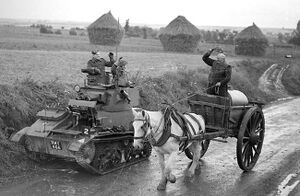
Founding
The Regiment's founding was assisted by the need for additional assets to fight in the rapidly growing Ardmori Civil War, where the armoured car squadrons of the Royal Arcerion Dragoons and Arcerion Loyal Horse were facing newer anti-tank weapons and the hardened bunkers and structures of the Ardmori communist forces required additional direct fire support, which the Dragoons and Loyal Horse were unable to provide as their armorued cars were only equipped with machineguns.
With Parliamentary approval, the Armoured Corps oversaw the creation of four squadrons of armoured forces, those being a Headquarters Squadron (HQ), as well as three lettered squadrons (A, B, and C) with the first two containing newly developed tanks produced by the Arcer automobile industry and the third Squadron organized as a combat support squadron with halftracks for reconnaissance as well as truck-towed anti-tank guns. These four squadrons were organized into 1 Arcerion Tank Regiment (1ATR). These forces were trained hastily at Presdale for the summer of 1929, staying in newly constructed lines and barracks and practicing gunnery, communication, maintenance, and coordination with infantry units.
Initial findings from these exercises was that the 2-pdr (40mm) were sufficient to support the infantry in assaults, and using high-explosive ammunition were able to achieve better fire superiority then the light-m and medium-machinegun equipped Dragoons and Loyal Horse. These, combined with the direct-fire guns in C Squadron boarded ships in the Fall of 1929 to be quickly sent overseas for service in Ardmore, where the latter stages of 1929 had seen a slow degradation of the Royal Army and the Loyalist faction's ability to withstand.
Ardmori Civil War
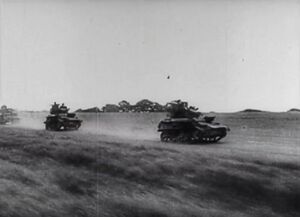
All four squadrons arrived at port shortly after Christmas Day, 1929 with a total of fifty tanks. They spent the first two weeks of the New Year preparing for movement, with fuel trucks and maintenance being conducted near the port facilities at Balnaessie. With preparations complete, the Regiment conducted its first road march to the South, and spent the next few months assisting members of the Royal Moorden Regiment who were conducting a slow fighting withdrawal from Wolford. The tanks saw their first action against multiple communist and socialist brigades, and lessons learned regarding the cooperation and coordination with combat engineers for the creation of defensive fighting positions helped the Regiment greatly.
B Squadron conducted a successful counter-attack in June of 1930, preventing a battalion from Northlea Rifle Regiment from being cut off after it had begun to run low on ammunition. During the course of the counter attack, the Regiment suffered its first combat losses, with the destruction of three tanks from the Squadron, and one lost due to maintenance issues with the engine, according to the Regimental archives.
By the end of 1930, Taernsby saw the Regiment reunited, as the Squadrons had been partitioned off the support different elements of the Arcer Army Brigades fighting in Ardmore. The reunification of the Regiment was to prepare for a counterattack during the evacuation of Taernsby, as Arco generals believed the South Island was no longer tenable to hold due to the crumbling Ardmori Army and increases in communist forces maneuvers. The town of Taernsby, located two hours East of Balnaessie, was the sight of significant fighting. A and B Squadrons, supported by C Squadron and elements of the Arcerion Loyal Horse, conducted a significant counter-attack, destroying one communist brigade and forcing another to retreat, allowing Loyalist forces to evacuate their troops and much of the sympathetic civilian populace.
The Regiment continued to fight during the Battle of the Southern Marshes, where it hastily went to defend the retreating Arcer and Ardmori forces attempting to reach the port of Kilikken as they withdrew from the numerically superior communist forces. This would be the Regiment's last action of the war, and it was withdrawn with the Kiravian-negotiated armistice in 1931. The war gave the Regiment much needed experience, as well as hard-fought lessons in modern armoured warfare. An importance on the use of radios, coordination with other elements (especially engineers), and the requirement for maintenance and repair units to be close by to assist with the repair and recovery of non-combat losses would all be applied thoroughly in the Second Great War.
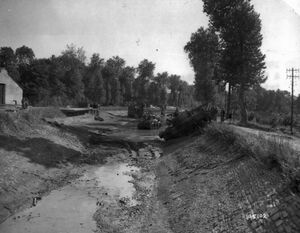
Second Great War
The Regiment deployed to the Second Great War with newer technology, tanks, and equipment then it had hastily entered its first conflict with. After successful landings in the Capetian Peninsula, the Arcerion Tank Regiment (now actually four Regiments, 1-4) landed to support conventional ground forces. They conducted a link-up with members of the Arcerion Parachute Regiment shortly after landing, and worked with regular infantry and mechanized formations to relieve successive Airborne units.
After the link ups and relief was provided to the Airborne, the Regiment sheltered in rear areas during the winter months of 1936-1937, sheltering for the summer fighting season of 1937. Of note was that the ATR was no longer the sole operator of tanks in the Arcer Army, with some cavalry units having been converted in the Interwar period as war with the Cape loomed larger.
The Regiment was the vanguard and at the forefront of Operation Severance, with the 1st and 2nd Arcerion Tank Regiments fighting to the outskirts of Cape Town, along with elements of the Royal Arcerion Regiment and the Northlea Rifle Regiment. Significant of this was the August 1937 Battle of Channel Beach between the 1st and 2nd ATR (as part of Battlegroup Dunfeld) and the Capetian 8th Mechanized Corps. Despite being heavily outnumbered, the Arcer forces managed to blunt the counter-offensive, and fix the 8th Mechanized in place while the 1st Division (Northlea) was relieved by another Arco Brigade. In the East, the 3rd and 4th Arcerion Tank Regiments took heavy casualties as they forced the Capetians out of the Southeastern coast. Most of the Capetian 2nd and 5th Armies were pinned in a narrow corridor between Arcer lines to the West, Paulastran forces to the North along the mountains, and the channel between the Cape and Ænora to the East. Much of the Capetian forces that remained used night time crossings to the Cape's island province of Cebek, where there was little presence of Arcer troops, save for aerial sorties over the contested sky. The 3rd and 4th Regiments sustained a significant number of casualties, with 3rd ATR being attrited to just a Squadron's (~19) worth of tanks by October 1937.

Fighting slowed drastically by the end of 1937, and with winter conditions yet again setting in, Arcer forces were unable to take Cape Town, having pushed Capetian troops into a narrow pocket within the city and the surrounding suburbs. Fierce urban fighting had taken a high toll on the armorued crews, and improvised armour (oftens sandbags or spare tracks) were used to help combat the often point-blank ambushes by Capetian infantry and conscript soldiers. Working with infantry and engineers, Arcer tankers cleared block-by-block during the Battles of the Bricks, named for the construction of Capetian homes in Cape Town's suburbs. By the summer of 1938, Capetian Forces, supported by Caphiria, had made costly but steady gains to push back the Eastern forces that Arcerion had entrenched on the channel crossing with Ænora. Fighting from Cebek, the Capetian forces harassed the beleaguered Arco troops. Unwilling to cede Cape Town's siege, the Arcer General Staff conducted a slow fighting withdrawal, until the eventual general withdrawal of the Regiment in September 1938.
Interwar Period
After the conclusion of the Second Great War, the Regiment was again to be the only armoured unit in the Arcer Army. Other cavalry units again became reconnaissance or anti-tank formations, and the 1st-4th Tank Regiments moved to their garrisons in Dalfearn and Presdale where they would spend the next few years. There was no major participation in the Istrenyan Crisis, as political sensitivities regarding the deployment of heavy weapons such as tanks or artillery was politically untenable in the Cold War climate. Despite this, a composite unit of D Squadron 1st ATR and D Squadron 2nd ATR was sent to Istrenya in armoured cars and armoured personnel carriers, to assist with clearance operations. Doing so met the Parliament's intent of not deploying tanks, but gave the light forces of the Royal Arcerion Infantry Corps much needed direct fire support.
During this time the Regiment began a serious period of trials and evaluations, trying to replace expensive and difficult to maintain Second Great War-vintage medium tanks with newer models. However budget cuts during the Occidental Cold War meant that heavier mechanized units were not as favourable for the return to police action-style deployments that were becoming more common.
Modern tanks would eventually be procured, with modern night vision systems, radios, ammunition, and laser rangefinders in the 1970s, shortly before the Fourth Bush War. Of note was that Arcerion was the first nation to adopt night vision in its vehicles, investing heavily into the consumer electronics and technology centres in the Levantine and domestic markets to help equip its armoured forces with the most modern equipment.
Fourth Bush War
The Regiment had a limited role in the Fourth Bush War. As the conflict was Counter-Insurgency (COIN) focused, the role of direct-fire support and armoured formations was drastically less important that previous conflicts. However the reconnaissance and combat support units of the ATR's supporting Squadrons played a significant role by assisting with the identification and targeting of communist forces along the border.
Telekonese Conflict
defense of dunborough
battle of westchester
Final War of the Deluge
See Also: Operation Pullman
The Regiment played a pivotal role in the Allied drive towards the Varshani capital of Anzio.
Current Structure
The current structure of the Regiment is reflective of the changes that it has undergone since the end of the Final War of the Deluge. It has been restructured to continue supporting Arcerion's mechanized brigades, and with the announcement of the creation of an additional mechanized brigade and a new armoured brigade, there will be an additional emphasis on the Regiment to force generate tank squadrons.
2022 Confederate Memo on Defence
The Memo was not a favourable document for outlining the future of either the Arcerion Armoured Corps or the Arcerion Tank Regiment. With the Next-Generation Main Battle Tank Procurement being cancelled, and more funds going towards lighter mechanized formations such as the armoured cavalry, the current generation of main battle tanks used by the Regiment were expected to serve into the 2040s, with life cycle and upgrade packages part of the plan to keep the Regiment's armoured vehicles in working order. This Memo was drafted and signed despite the Regiment's high profile participation in the Final War of the Deluge, notably Operation Pullman, where it led the Allied drive towards the Varshani Capital of Anzio. However political pressure on the Arcer General Staff to make the military more flexible and expeditionary deployable ultimately meant that the Regiment was to see a period of plateau for capabilities, funding, equipment, and personnel.
Squadrons and Units
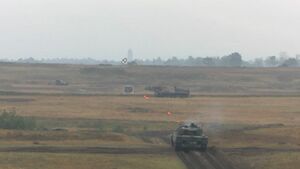
The current Regimental status as of 2026 is as follows:
1st Arcerion Tank Regiment (attached to 1 Rifle Brigade) - Arcerion Armed Forces Base Dalfearn
- HQ Squadron
- A Squadron
- B Squadron
- C Squadron
- D Squadron (Recce & Combat Support)
2nd Arcerion Tank Regiment (attached to 4 Mechanized Brigade) - Arcerion Armed Forces Base Presdale
- HQ Squadron
- E Squadron
- F Squadron
- G Squadron
- H Squadron (Recce & Combat Support)
3rd Arcerion Tank Regiment (attached to 5 Mechanized Brigade) - Arcerion Armed Forces Base Dalfearn
- HQ Squadron
- I Squadron
- J Squadron
- K Squadron
- L Squadron (Recce & Combat Support)
Regiments are usually organized into three tank squadrons of 19 tanks each, with a combat support squadron consisting of LAVs, anti-tank guided missile carriers, mortars, and other enabling assets to assist maneuver commanders.
Basing
The Regiment is based across a variety of Arcerion Armed Forces Bases, but notably those at Dalfearn and Presdale due to their proxomity to the Arcer Heartland and access to large training areas to conduct maneuver warfare. The Regiment also has a significant part of the live fire ranges that make up the Arcerion Maneuver Training Center assigned to it as part of its yearly gunnery and combat team verifications.
Equipment
Armoured Fighting Vehicles
The Arcerion Tank Regiment has a number of non-tank armoured fighting vehicles in its inventory. The primary of these is the LAV-series, or Light Armorued Vehicle. Armed with a 25mm chaingun and based on an 8x8 chassis, the LAV is a versaile platform that can serve in a variety of roles. It is primarily found as a command post variant, mortar carrier, ambluance, repair and recovery vehicle, or in its reconnaisance configuration with a large sensor suite mounted on an extendable mast in the vehicle's rear. First adopted in the 1990s, the LAV-series is the most predominant armoured vehicle in Arcerion's Army.
Within the ATR, the LAV is most commonly found in the Combat Support Squadrons in the reconnaissance troops.
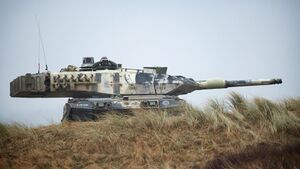
Main Battle Tanks
The primary vehicle of the Arcerion Tank Regiment is the Main Battle Tank. Arcerion's current main battle tank was developed and trialed in the 1980s, being introduced into service in the early 1990s along with the LAV. It is based on a tracked chassis and has a 120mm smoothbore cannon, capable of firing a variety of rounds from Armour Piercing Fin Discarding Sabot (APFSDS) to High-Explosive. It also carries several coaxial and pintle-mounted machineguns for infantry or soft targets. The main battle tank also has a chassis for an armoured recovery vehicle (ARV) that assists with engineering and maintenance tasks for the main battle tanks.
The current MBT has undergone a series of upgrades to its night vision, thermal imaging, radio communications, and fire control systems to ensure it is at a modern 21st century standard.
Other Equipment
Regimental Alliances
Alstin
Burg